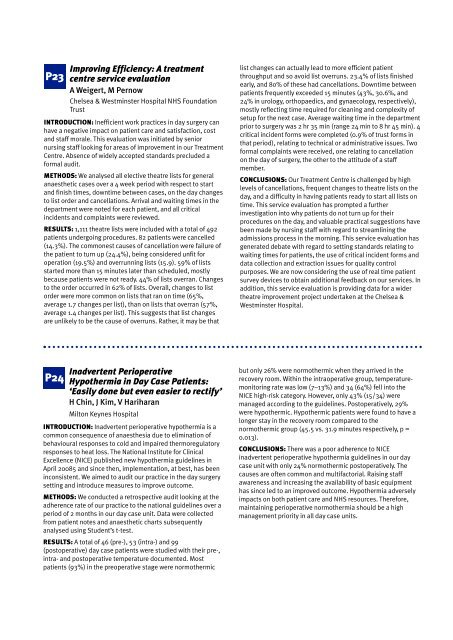One-Day Surgery - British Association of Day Surgery
One-Day Surgery - British Association of Day Surgery
One-Day Surgery - British Association of Day Surgery
Create successful ePaper yourself
Turn your PDF publications into a flip-book with our unique Google optimized e-Paper software.
P23<br />
Improving Efficiency: A treatment<br />
centre service evaluation<br />
A Weigert, M Pernow<br />
Chelsea & Westminster Hospital NHS Foundation<br />
Trust<br />
INTRODUCTION: Inefficient work practices in day surgery can<br />
have a negative impact on patient care and satisfaction, cost<br />
and staff morale. This evaluation was initiated by senior<br />
nursing staff looking for areas <strong>of</strong> improvement in our Treatment<br />
Centre. Absence <strong>of</strong> widely accepted standards precluded a<br />
formal audit.<br />
METHODS: We analysed all elective theatre lists for general<br />
anaesthetic cases over a 4 week period with respect to start<br />
and finish times, downtime between cases, on the day changes<br />
to list order and cancellations. Arrival and waiting times in the<br />
department were noted for each patient, and all critical<br />
incidents and complaints were reviewed.<br />
RESULTS: 1,111 theatre lists were included with a total <strong>of</strong> 492<br />
patients undergoing procedures. 82 patients were cancelled<br />
(14.3%). The commonest causes <strong>of</strong> cancellation were failure <strong>of</strong><br />
the patient to turn up (24.4%), being considered unfit for<br />
operation (19.5%) and overrunning lists (15.9). 59% <strong>of</strong> lists<br />
started more than 15 minutes later than scheduled, mostly<br />
because patients were not ready. 44% <strong>of</strong> lists overran. Changes<br />
to the order occurred in 62% <strong>of</strong> lists. Overall, changes to list<br />
order were more common on lists that ran on time (65%,<br />
average 1.7 changes per list), than on lists that overran (57%,<br />
average 1.4 changes per list). This suggests that list changes<br />
are unlikely to be the cause <strong>of</strong> overruns. Rather, it may be that<br />
P24<br />
Inadvertent Perioperative<br />
Hypothermia in <strong>Day</strong> Case Patients:<br />
‘Easily done but even easier to rectify’<br />
H Chin, J Kim, V Hariharan<br />
Milton Keynes Hospital<br />
INTRODUCTION: Inadvertent perioperative hypothermia is a<br />
common consequence <strong>of</strong> anaesthesia due to elimination <strong>of</strong><br />
behavioural responses to cold and impaired thermoregulatory<br />
responses to heat loss. The National Institute for Clinical<br />
Excellence (NICE) published new hypothermia guidelines in<br />
April 20085 and since then, implementation, at best, has been<br />
inconsistent. We aimed to audit our practice in the day surgery<br />
setting and introduce measures to improve outcome.<br />
METHODS: We conducted a retrospective audit looking at the<br />
adherence rate <strong>of</strong> our practice to the national guidelines over a<br />
period <strong>of</strong> 2 months in our day case unit. Data were collected<br />
from patient notes and anaesthetic charts subsequently<br />
analysed using Student’s t-test.<br />
RESULTS: A total <strong>of</strong> 46 (pre-), 53 (intra-) and 99<br />
(postoperative) day case patients were studied with their pre-,<br />
intra- and postoperative temperature documented. Most<br />
patients (93%) in the preoperative stage were normothermic<br />
list changes can actually lead to more efficient patient<br />
throughput and so avoid list overruns. 23.4% <strong>of</strong> lists finished<br />
early, and 80% <strong>of</strong> these had cancellations. Downtime between<br />
patients frequently exceeded 15 minutes (43%, 30.6%, and<br />
24% in urology, orthopaedics, and gynaecology, respectively),<br />
mostly reflecting time required for cleaning and complexity <strong>of</strong><br />
setup for the next case. Average waiting time in the department<br />
prior to surgery was 2 hr 35 min (range 24 min to 8 hr 45 min). 4<br />
critical incident forms were completed (0.9% <strong>of</strong> trust forms in<br />
that period), relating to technical or administrative issues. Two<br />
formal complaints were received, one relating to cancellation<br />
on the day <strong>of</strong> surgery, the other to the attitude <strong>of</strong> a staff<br />
member.<br />
CONCLUSIONS: Our Treatment Centre is challenged by high<br />
levels <strong>of</strong> cancellations, frequent changes to theatre lists on the<br />
day, and a difficulty in having patients ready to start all lists on<br />
time. This service evaluation has prompted a further<br />
investigation into why patients do not turn up for their<br />
procedures on the day, and valuable practical suggestions have<br />
been made by nursing staff with regard to streamlining the<br />
admissions process in the morning. This service evaluation has<br />
generated debate with regard to setting standards relating to<br />
waiting times for patients, the use <strong>of</strong> critical incident forms and<br />
data collection and extraction issues for quality control<br />
purposes. We are now considering the use <strong>of</strong> real time patient<br />
survey devices to obtain additional feedback on our services. In<br />
addition, this service evaluation is providing data for a wider<br />
theatre improvement project undertaken at the Chelsea &<br />
Westminster Hospital.<br />
but only 26% were normothermic when they arrived in the<br />
recovery room. Within the intraoperative group, temperaturemonitoring<br />
rate was low (7–13%) and 34 (64%) fell into the<br />
NICE high-risk category. However, only 43% (15/34) were<br />
managed according to the guidelines. Postoperatively, 29%<br />
were hypothermic. Hypothermic patients were found to have a<br />
longer stay in the recovery room compared to the<br />
normothermic group (45.5 vs. 31.9 minutes respectively, p =<br />
0.013).<br />
CONCLUSIONS: There was a poor adherence to NICE<br />
inadvertent perioperative hypothermia guidelines in our day<br />
case unit with only 24% normothermic postoperatively. The<br />
causes are <strong>of</strong>ten common and multifactorial. Raising staff<br />
awareness and increasing the availability <strong>of</strong> basic equipment<br />
has since led to an improved outcome. Hypothermia adversely<br />
impacts on both patient care and NHS resources. Therefore,<br />
maintaining perioperative normothermia should be a high<br />
management priority in all day case units.


